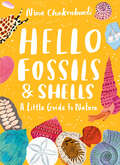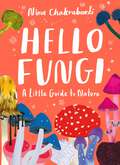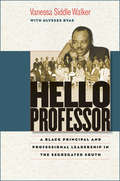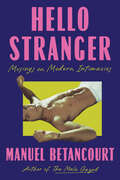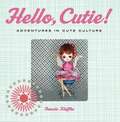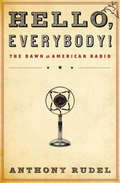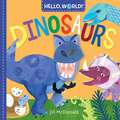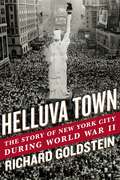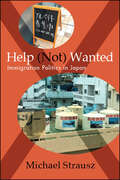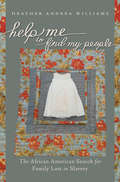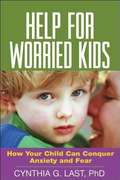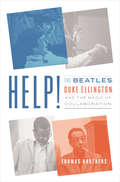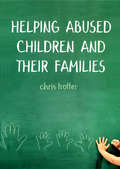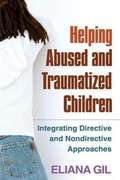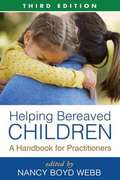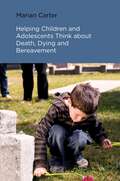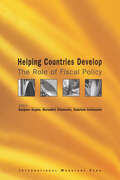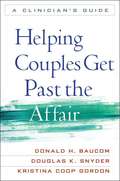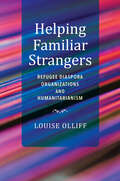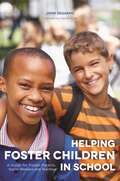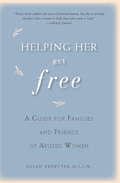- Table View
- List View
Hello Fossils and Shells (Little Guides to Nature #4)
by Nina ChakrabartiGet outside and explore a world of fascinating fossils and shells with this beautifully illustrated pocket guide for children.Why do some shells have shimmery rainbow linings? And can you tell a trilobite from an ammonite? Beautiful gallery-style pages showcase creatures fossilised in amber, spiny fossils and an amazing array of colourful seashells. Fun off-the-page activity spreads include tips on fossil hunting and how to make fossil imprints using shells.With colourful illustrations and amazing facts, outdoor activities to try and features on shell patterns, great fossil finds and living fossils, this little book will provide hours of pleasure, both indoors and out.Be inspired to go outdoors and get up close with nature with this brand-new series from internationally bestselling illustrator Nina Chakrabarti. Also in this series: Hello Trees, Hello Fungi and Hello Bugs.
Hello Fungi: A Little Guide To Nature (Little Guides to Nature #2)
by Nina ChakrabartiGet outside and explore the fascinating world of fungi with this beautifully illustrated pocket guide.Did you know that fungi are not quite plant, not quite animal and not quite bacteria, but a unique organism in a kingdom all of their own? Beautiful gallery-style pages showcase a fascinating world of fungi, including glow-in-dark fungi, the funky fungi that give off the strongest smell and the most colourful fungi. Creative off-the-page activity spreads include how to make a spore print and a recipe for delicious store-bought mushrooms on toast.With tips on mushroom identification (including the ones to avoid!), fungi-based activities to enjoy, and a guide to the most colourful and unusual mushrooms, this little book will provide hours of pleasure, both indoors and out.Be inspired to go outdoors and get up close with nature with this brand-new series from internationally bestselling illustrator Nina Chakrabarti. Also in this series: Hello Trees, Hello Bugs and Hello Fossils and Shells.
Hello Professor: A Black Principal and Professional Leadership in the Segregated South
by Vanessa Siddle Walker Ulysses ByasLike many black school principals, Ulysses Byas, who served the Gainesville, Georgia, school system in the 1950s and 1960s, was reverently addressed by community members as "Professor." He kept copious notes and records throughout his career, documenting efforts to improve the education of blacks. Through conversations with Byas and access to his extensive archives on his principalship, Vanessa Siddle Walker finds that black principals were well positioned in the community to serve as conduits of ideas, knowledge, and tools to support black resistance to officially sanctioned regressive educational systems in the Jim Crow South. Walker explains that principals participated in local, regional, and national associations, comprising a black educational network through which power structures were formed and ideas were spread to schools across the South. The professor enabled local school empowerment and applied the collective wisdom of the network to pursue common school projects such as pressuring school superintendents for funding, structuring professional development for teachers, and generating local action that was informed by research in academic practice. The professor was uniquely positioned to learn about and deploy resources made available through these networks. Walker's record of the transfer of ideology from black organizations into a local setting illuminates the remembered activities of black schools throughout the South and recalls for a new generation the role of the professor in uplifting black communities.
Hello Stranger: Musings on Modern Intimacies
by Manuel BetancourtWitty and winkingly playful, Manuel Betancourt&’s Hello Stranger explores modern queer romance and the expansive possibilities of ephemeral intimacies&“Hello stranger.&” As an opening line, you really can&’t ask for better.Hello Stranger is a book about chance encounters—at a bar, through social media, in a bathhouse—and what a stranger can reveal about who we are and who we could still yet be. A stranger, after all, is a site of endless possibilities.As Manuel Betancourt looks back on his past relationships, he turns to characters and narratives that helped him question notions of what monogamy and coupledom (and relationships and marriage) can and should look like. From films like Before Sunrise and Cruising to the poetry of Frank O'Hara and the musicals of Stephen Sondheim, Betancourt uses pop culture to make sense of the alluring prospect of forging intimacies with strangers—even, or especially, the strangers within ourselves.At once a personal excavation and a broad cultural critique, Betancourt grapples with everything from online sexting and real-life cruising to divorces and throuples. Hello Stranger examines the intimacies we crave, value, and oftentimes destroy with rote familiarity.
Hello Trees (Little Guides to Nature #1)
by Nina ChakrabartiGet outside and explore the magnificent world of trees with this beautifully illustrated pocket guide.Witness a tree's growth from seed to sapling and discover how trees come together to support each other in forests in this beautiful pocket guide to nature. Illustrated gallery-style pages show children how to identify a tree from its seeds, take a closer look leaf function and shape and highlights some of the oldest and the tallest trees from around the world.A book to inspire budding naturalists aged 6 and up, Hello Trees also includes creative off-the-page activities for children to try, including growing a tree from an avocado seed and creating amazing art by painting leaves and bark rubbing.Be inspired to go outdoors and get up close with nature with this brand-new series from internationally bestselling illustrator Nina Chakrabarti. Also in this series: Hello Fungi, Hello Bugs and Hello Fossils and Shells.
Hello, Cutie!
by Pamela KlaffkeA doe-eyed doll, a smiley-faced cupcake, a sweet plush kitten: they're cute?and cute is at the heart of a growing legion of adult collectors and enthusiasts who live and breathe all things cuddly and adorable.Journalist and writer Pamela Klaffke, author of Spree: A Cultural History of Shopping and herself an avid collector of cute since she was a child, takes readers on a rainbow-and-unicorn-filled journey through cute culture, from its origins in Japan where teenaged girls help drive the "cute" economy, to its modern-day manifestations in the bubblegum-colored careers of performers like Katy Perry. The book also delves into the fanatical world of cute creators and collectors, the psychology of nostalgia, and the phenomenon known as creepy/cute. There's also cute food, anthropomorphized animals, and cute superstars such as Blythe, My Little Pony, and Hello Kitty herself. Full-color throughout, the book also includes many photographs of cute objects from the author's extensive personal collection.As charming and captivating as its subject matter, Hello, Cutie! invites readers to indulge their cuddliest guilty pleasures. It's as cute as can be!Pamela Klaffke is the author of Spree: A Cultural History of Shopping.
Hello, Everybody!: The Dawn of American Radio
by Anthony Rudel&“A lively overview&” of this pre-internet mass-communication tool and &“the entrepreneurs and evangelists, hucksters and opportunists&” who flocked to it (Publishers Weekly). Long before the Internet, another young technology was transforming the way we connect with the world. At the dawn of the twentieth century, radio grew from an obscure hobby into a mass medium with the power to reach millions of people. When amateur enthusiasts began sending fuzzy signals from their garages and rooftops, radio broadcasting was born. Sensing the medium&’s potential, snake-oil salesmen and preachers took to the air, innovating styles of mass communication and entertainment while making bedlam of the airwaves. Into this wild new frontier stepped a young secretary of commerce, Herbert Hoover, whose passion for organization transformed radio into an even more powerful political, cultural and economic force. When a charismatic bandleader named Rudy Vallée created the first on-air variety show and America elected Franklin Delano Roosevelt, who communicated with the public through his famous fireside chats, radio had arrived. With extensive knowledge, humor, and an eye for outsized characters forgotten by history, Anthony Rudel tells the story of the boisterous years when radio took its place in the nation&’s living room. &“Entertaining and informative.&” —The Denver Post &“Rudel, with extensive professional radio experience, revels in the enterprising personalities who set up shop on this technological frontier. . . .[And] vividly re-creates the anything-goes atmosphere of the ether&’s early days.&” —Booklist
Hello, World! Dinosaurs (Hello, World!)
by Jill McDonaldLearn from home and explore the world with these fun and easy board books!All young children love dinosaurs. Here&’s a Hello, World! board book that teaches toddlers all about Triceratops, Stegosaurus, T-rex, and many more—with colors, shapes, sizes, and super-simple facts. Hello, World! is a series designed to introduce first nonfiction concepts to babies and toddlers. Told in clear and easy terms (&“T. rex&’s arms were very small, even though its body was large&”) and featuring bright, cheerful illustrations, Hello, World! makes learning fun for young children. And each sturdy page offers helpful prompts for engaging with your child. It&’s a perfect way to bring science and nature into the busy world of a toddler, where learning never stops. Look for all the books in the Hello, World! series: • Solar System• Weather• Backyard Bugs• Birds• Dinosaurs• My Body• How Do Apples Grow?• Ocean Life• Moon Landing• Pets• Arctic Animals• Construction Site• Rainforest Animals• Planet Earth • Reptiles• Cars and Trucks • Music• Baby Animals• On the Farm• Garden Time• Planes and Other Flying Machines• Rocks and Minerals• Snow
Helluva Town
by Richard GoldsteinIn the stirring signature number from the 1944 Broadway musical On the Town, three sailors on a 24-hour search for love in wartime Manhattan sing, "New York, New York, a helluva town." The Navy boys' race against time mirrored the very real frenzy in the city that played host to 3 million servicemen, then shipped them out from its magnificent port to an uncertain destiny. This was a time when soldiers and sailors on their final flings jammed the Times Square movie houses featuring lavish stage shows as well as the nightclubs like the Latin Quarter and the Copacabana; a time when bobby-soxers swooned at the Paramount over Frank Sinatra, a sexy, skinny substitute for the boys who had gone to war. Richard Goldstein's Helluva Town is a kaleidoscopic and compelling social history that captures the youthful electricity of wartime and recounts the important role New York played in the national war effort. This is a book that will prove irresistible to anyone who loves New York and its relentlessly fascinating saga. Wartime Broadway lives again in these pages through the plays of Lillian Hellman, Robert Sherwood, Maxwell Anderson, and John Steinbeck championing the democratic cause; Irving Berlin's This Is the Army and Moss Hart's Winged Victory with their all-servicemen casts; Rodgers and Hammerstein's Oklahoma! hailing American optimism; the Leonard Bernstein-Jerome Robbins production of On the Town; and the Stage Door Canteen. And these were the days when the Brooklyn Navy Yard turned out battleships and aircraft carriers, when troopships bound for Europe departed from the great Manhattan piers where glamorous ocean liners once docked, where the most beautiful liner of them all, the Normandie, caught fire and capsized during its conversion to a troopship. Here, too, is an unseen New York: physicists who fled Hitler's Europe spawning the atomic bomb, the FBI chasing after Nazi spies, the Navy enlisting the Mafia to safeguard the port against sabotage, British agents mounting a vast intelligence operation. This is the city that served as a magnet for European artists and intellectuals, whose creative presence contributed mightily to New York's boisterous cosmopolitanism. Long before 9/11, New York felt vulnerable to a foreign foe. Helluva Town recalls how 400,000 New Yorkers served as air-raid wardens while antiaircraft guns ringed the city in anticipation of a German bombing raid. Finally, this is the story of New York's emergence as the power and glory of the world stage in the wake of V-J Day, underlined when the newly created United Nations arose beside the East River, climaxing a storied chapter in the history of the world's greatest city.
Help (Not) Wanted: Immigration Politics in Japan
by Michael StrauszIn Help (Not) Wanted, Michael Strausz offers an original and provocative answer to a question that has long perplexed observers of Japan: Why has Japan's immigration policy remained so restrictive, especially in light of economic, demographic, and international political forces that are pushing Japan to admit more immigrants? Drawing upon insights developed during nearly two years of intensive field research in Japan, Strausz ultimately argues that Japan's immigration policy has remained restrictive for two reasons. First, Japan's labor-intensive businesses have failed to defeat anti-immigration forces within the Japanese state, particularly those in the Ministry of Justice and the Japanese Diet. Second, no influential strain of elite thought in postwar Japan exists to support the idea that significant numbers of foreign nationals have a legitimate claim to residency and citizenship. This book is particularly timely at a moment shaped by Brexit, the election of Trump, and the rise of anti-immigrant political parties and nativist rhetoric across the globe.
Help Me to Find My People
by Heather Andrea WilliamsAfter the Civil War, African Americans placed poignant "information wanted" advertisements in newspapers, searching for missing family members. Inspired by the power of these ads, Heather Andrea Williams uses slave narratives, letters, interviews, public records, and diaries to guide readers back to devastating moments of family separation during slavery when people were sold away from parents, siblings, spouses, and children. Williams explores the heartbreaking stories of separation and the long, usually unsuccessful journeys toward reunification. Examining the interior lives of the enslaved and freedpeople as they tried to come to terms with great loss, Williams grounds their grief, fear, anger, longing, frustration, and hope in the history of American slavery and the domestic slave trade. Williams follows those who were separated, chronicles their searches, and documents the rare experience of reunion. She also explores the sympathy, indifference, hostility, or empathy expressed by whites about sundered black families. Williams shows how searches for family members in the post-Civil War era continue to reverberate in African American culture in the ongoing search for family history and connection across generations.
Help Your Teenager Beat an Eating Disorder
by James Lock Daniel Le GrangeEating disorders are among the most dangerous--and misunderstood--adolescent mental health problems. When your teenager shows signs of an eating disorder, where can you turn? Now in a revised and updated third edition, this trusted resource helps you separate fact from myth and play an active role in your child's recovery. Treatment experts James Lock and Daniel Le Grange spell out what parents need to know about anorexia nervosa, bulimia nervosa, binge-eating disorder, and avoidant/restrictive food intake disorder (ARFID). They guide you step by step to find the right care, monitor your teen's eating and exercise habits, manage family meals, end weight-related power struggles, and team successfully with professionals. The revised third edition incorporates key research and treatment advances, new vignettes, and expanded coverage of ARFID. When families work together to get the most out of treatment and prevent relapse, eating disorders can be beat--this book is your essential roadmap.
Help for Worried Kids
by Cynthia LastIf your son begs to stay home from school to avoid speaking in front of the class, should you be worried? If your daughter insists on crossing the street whenever she sees a dog, what should you do? A simple evaluation devised by renowned psychologist Dr. Cynthia G. Last can help you determine if you have reason to be concerned. If so, you can use Dr. Last's checklists and examples to figure out the type and severity of your child's anxiety, identify contributing factors, and tackle the problem head on. Strategies tailored for different kinds of anxiety will guide you in preventing new episodes, calming your child when a problem arises, and keeping anxieties in check as your son or daughter matures. Dr. Last delivers powerful advice and insightful information gleaned from 25 years of experience working with worried kids and their families, including coping and relaxation skills your child can use to reduce stress and worry, and tips for encouraging kids to approach--not avoid--their fears. Whether your son or daughter can't go on sleepovers, gets nervous around peers, or just plain worries about "everything," this reassuring and compassionate book will teach you how to soothe your child's immediate fears and instill lasting confidence.
Help!: The Beatles, Duke Ellington, And The Magic Of Collaboration
by Thomas BrothersThe fascinating story of how creative cooperation inspired two of the world’s most celebrated musical acts. The Beatles and Duke Ellington’s Orchestra stand as the two greatest examples of collaboration in music history. Ellington’s forte was not melody—his key partners were not lyricists but his fellow musicians. His strength was in arranging, in elevating the role of a featured soloist, in selecting titles: in packaging compositions. He was also very good at taking credit when the credit wasn’t solely his, as in the case of Mood Indigo, though he was ultimately responsible for the orchestration of what Duke University musicologist Thomas Brothers calls "one of his finest achievements." If Ellington was often reluctant to publicly acknowledge how essential collaboration was to the Ellington sound, the relationship between Lennon and McCartney was fluid from the start. Lennon and McCartney "wrote for each other as primary audience." Lennon’s preference for simpler music meant that it begged for enhancement and McCartney was only too happy to oblige, and while McCartney expanded the Beatles’ musical range, Lennon did "the same thing with lyrics." Through his fascinating examination of these two musical legends, Brothers delivers a portrait of the creative process at work, demonstrating that the cooperative method at the foundation of these two artist-groups was the primary reason for their unmatched musical success. While clarifying the historical record of who wrote what, with whom, and how, Brothers brings the past to life with a lifetime of musical knowledge that reverberates through every page, and analyses of songs from Lennon and McCartney’s Strawberry Fields Forever to Billy Strayhorn’s Chelsea Bridge. Help! describes in rich detail the music and mastery of two cultural leaders whose popularity has never dimmed, and the process of collaboration that allowed them to achieve an artistic vision greater than the sum of their parts.
Helping Abused Children and their Families: Towards an evidence-based practice model
by Chris TrotterThis book gives us fresh insights into the complex task of child protection and must be essential reading for all those engaged in this demanding work. Both practitioners and policy makers will find much to stimulate them here.'Robbie Gilligan, Professor of Social Work and Social Policy and Associate Director of the Children's Research Centre at Trinity College Dublin This book moves beyond investigation and risk assessment to decision making about the most effective ways of working with a family. Trotter provides a strong case for why practitioners should make these decisions evidence based. Only with such an approach is it going to be possible to increase the confidence of those working in child protection.' Professor Margaret Lynch, Editor, Child Abuse Review 1992-2003Child protection is one of the most challenging and at times frustrating fields of practice in the human services. In Helping Abused Children and their Families Chris Trotter explains what works and what doesn't work in child protection. Drawing on a major study and current international research, he shows that rates of re-abuse and client and worker satisfaction can be improved with an evidence-based approach to intervention. He develops his research based practice model, including role clarification, problem solving, pro-social modelling and client-worker relationship skills. Using case studies, Trotter shows how this model can be used in a range of situations.Helping Abused Children and Their Families is an invaluable reference for child protection workers and for students. It will also appeal to readers interested in an evidence-based approach to work in child welfare and child protection.
Helping Abused and Traumatized Children
by Eliana GilPresenting an integrative model for treating traumatized children, this book combines play, art, and other expressive therapies with ideas and strategies drawn from cognitive-behavioral and family therapy. Eliana Gil demonstrates how to tailor treatment to the needs of each child by using both directive and nondirective approaches. Throughout, practical clinical examples illustrate ways to target trauma-related symptomatology while also helping children process painful feelings and memories that are difficult to verbalize. The book concludes with four in-depth cases that bring to life the unique situation of each child and family, the decision making process of the therapist, and the applications of developmentally informed, creative, and flexible interventions.
Helping Babies and Children Aged 0-6 to Heal After Family Violence: A Practical Guide to Infant- and Child-Led Work
by Dr Julie Stone Dr Wendy BunstonAfter family violence, very young children and babies benefit from child-led therapy, but how do you achieve this? Dr. Wendy Bunston's guide is here to help you to meet the emotional needs of children who are experiencing trauma, and to enable them to form healthy attachments, both within their families and beyond. As well as clearly explaining the consequences of domestic violence on young developing brains, this book demystifies the practicalities of working effectively with children in their earliest years. Examining real-life cases, it notes the distress that arises when a child is separated from his or her family, advises on the importance and complexities of children's attachments, and shows how to support playfulness as an essential part of children's healthy personal development. Instruction is provided on how to include all family members in the healing process, including the perpetrators of family violence, in a positive way to improve children's chances of recovery. Dr. Wendy Bunston's unique approach to therapy and care, based on over 25 years' professional experience, promotes the viewing of cases from a 'child-led' perspective. Pragmatic, empathic and accessible, this book will be essential reading for anyone working with those affected by domestic violence.
Helping Bereaved Children, Third Edition
by Nancy WebbThis acclaimed work presents a range of counseling and therapy approaches for children who have experienced loss. Practitioners and students are given practical strategies for helping preschoolers through adolescents cope with different forms of bereavement, including death in the family, school, or community. Grounded in the latest research on child therapy, bereavement, trauma, and child development, the volume clearly explains the principles that guide interventions. Featuring a wealth of new content, the third edition retains the case-based format and rich descriptions of the helping process that have made the book so popular as a practitioner guide and text. New to This Edition Significantly revised and updated to reflect new information and approaches; 9 new topics covered. Covers additional types of loss war-related death in the family, deaths connected to natural disasters, and the loss of a pet. Additional therapy modalities cognitive-behavioral therapy and play therapy; conjoint caregiver child treatment; and bereavement groups and camps. Addresses how to help parents and teachers meet bereaved children's needs. Includes 11 reproducible assessment tools and handouts that can also be downloaded and printed from Guilford's website.
Helping Beyond the 50-Minute Hour: Therapists Involved in Meaningful Social Action
by Jeffrey A. Kottler Jon Carlson Matt Englar-Carlson"Slacktivism" is a term that has been coined to cynically describe the token efforts that people devote to some cause, without long-term or meaningful impact. We wear colored wristbands, pins, or ribbons proclaiming support for a particular organization. We might post something on social network sites or send messages to friends about causes dear to our hearts. We might even volunteer our time to work on behalf of marginalized, oppressed, or neglected groups—or donate money to a charity. Yet the key feature of significant social action is follow through—continuing efforts over a period of time so as to build meaningful relationships, provide adequate support, and conduct evaluations to measure results and make needed adjustments that make programs even more responsive. This book is intended as an inspiration for practicing psychotherapists and counselors, as well as students, to become actively involved in a meaningful effort. The authors have searched far and wide to identify practitioners representing different disciplines, helping professions, geographic regions, and social action projects, all of whom have been involved in social justice efforts for some time, whether in their own communities or in far-flung regions of the world. Each of them has an amazing story to tell that reveals the challenges they’ve faced, the incredible satisfactions they’ve experienced, and what lessons they’ve learned along the way. Each story represents a gem of wisdom, revealing both questions of faith, as well as of sustained action. The authors have been encouraged to dig deeply in order to talk about the honest realities of their work. After reading their stories, you will be ready to pick a cause that speaks to you and begin your own work.
Helping Children and Adolescents Think about Death, Dying and Bereavement
by Marian CarterHow can children begin to understand death and cope with bereavement? And how can we, as adults, support and engage with children as they encounter this complex subject? Exploring how children and adolescents can engage with all aspects of death, dying and bereavement, this comprehensive guide looks at how children comprehend the death of a pet or someone close to them, their own dying, bereavement and grieving. It covers how you should discuss death with children, with a particular emphasis on the importance of listening to the child and adapting your approach based on their responses. The book offers guidance on how your own experiences of loss can provide you with models for your interactions with children on the subject of death.
Helping Countries Develop: The Role Of Fiscal Policy
by Benedict J. Clements, Sanjeev Gupta, Gabriela InchausteA report from the International Monetary Fund.
Helping Couples Get Past the Affair
by Donald Baucom Douglas SnyderFrom leading marital therapists and researchers, this unique book presents a three-stage therapy approach for clinicians working with couples struggling in the aftermath of infidelity. The book provides empirically grounded strategies for helping clients overcome the initial shock, understand what happened and why, think clearly about their best interests before they act, and move on emotionally, whether or not they ultimately reconcile. The volume is loaded with vivid clinical examples and carefully designed exercises for use both during sessions and at home.
Helping Familiar Strangers: Refugee Diaspora Organizations and Humanitarianism (Worlds in Crisis: Refugees, Asylum, and Forced Migration)
by Louise OlliffWho helps in situations of forced displacement? How and why do they get involved?In Helping Familiar Strangers, Louise Olliff focuses on one type of humanitarian group, refugee diaspora organizations (RDOs), to explore the complicated impulses, practices, and relationships between these activists and the "familiar strangers" they try to help. By documenting findings from ethnographic research and interviews with resettled and displaced persons, RDO representatives, and humanitarian professionals in Australia, Switzerland, Thailand, and Indonesia, Olliff reveals that former refugees are actively involved in helping people in situations of forced displacement and that individuals with lived experience of forced displacement have valuable knowledge, skills, and networks that can be drawn on in times of humanitarian crisis.We live in a world where humanitarians have varying motivations, capacities, and ways of helping those in need, and Helping Familiar Strangers confirms that RDOs and similar groups are an important part of the tapestry of care that people turn to when seeking protection far from home.
Helping Foster Children In School: A Guide for Foster Parents, Social Workers and Teachers
by John DegarmoHelping Foster Children In School explores the challenges that foster children face in schools and offers positive and practical guidance tailored to help the parents, teachers and social workers supporting them. Children in care often perform poorly at school both in terms of their behavior and their academic performance, with many failing to complete their education. They will have often experienced trauma or neglect which can result in a number of developmental delays. By looking at why children in foster care do not perform as well as their counterparts, John DeGarmo, who has fostered more than 40 children, provides easy-to-use strategies to target the problems commonly faced. He emphasizes the importance of an open dialogue between teacher, parent and social worker, to ensure that everyone is working jointly to achieve the best outcome for the child. An invaluable resource for foster parents, social workers and educators alike, this book encourages a unified response to ensure foster children are given the best chance to succeed at school.
Helping Her Get Free: A Guide for Families and Friends of Abused Women
by Mssw Susan BrewsterSeal Press originally published Helping Her Get Free with the title To Be an Anchor in the Storm. The survivor of an abusive relationship herself and a licensed counselor of abused women for more than a decade, Susan Brewster teaches readers how to recognize the signs of abuse, handle negative feelings, become an effective advocate, deal with the abuser, and more. With a new introduction and updated resource section, this straightforward and compassionate book offers the information needed to help give strength to women who are trying to break free.
